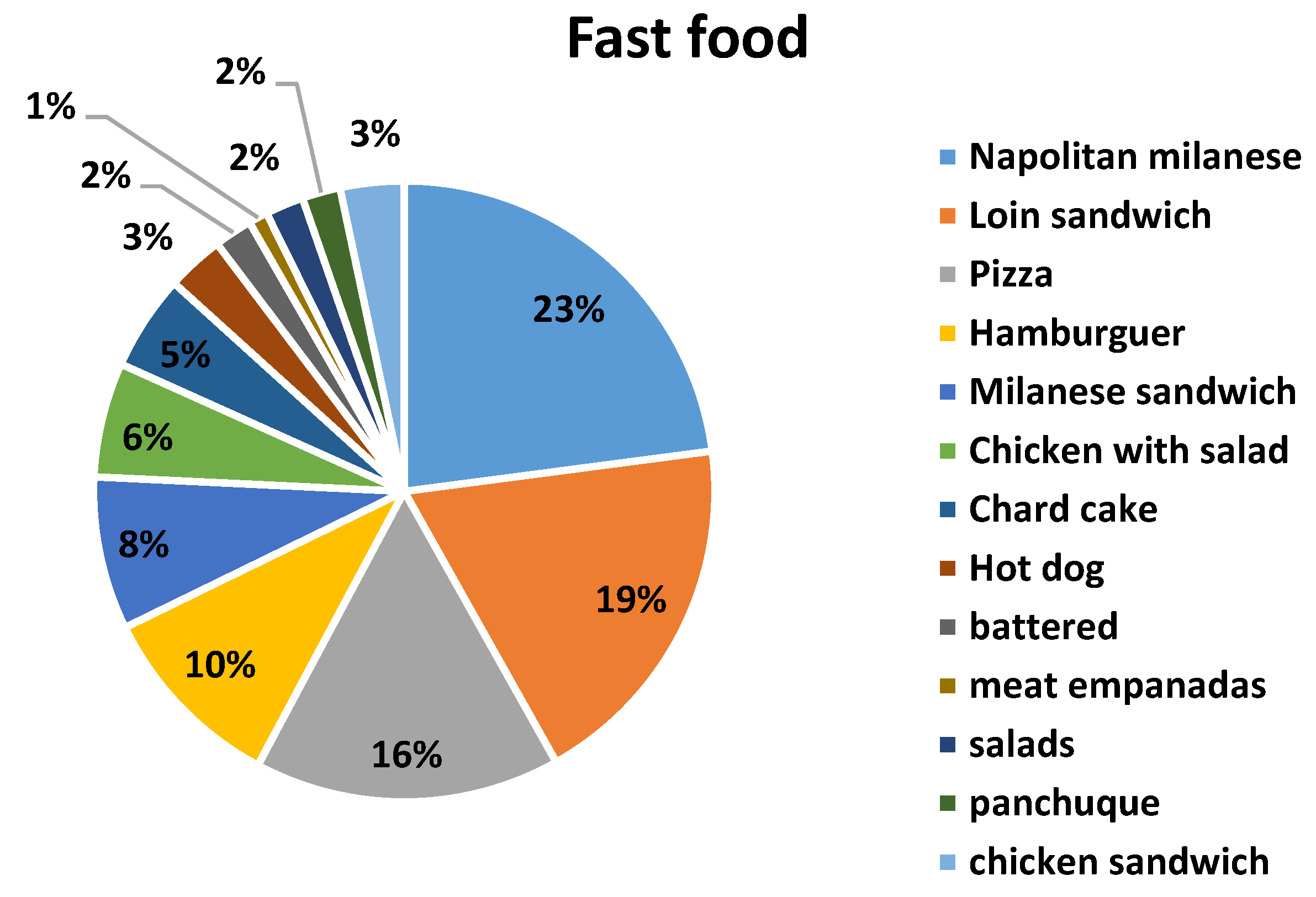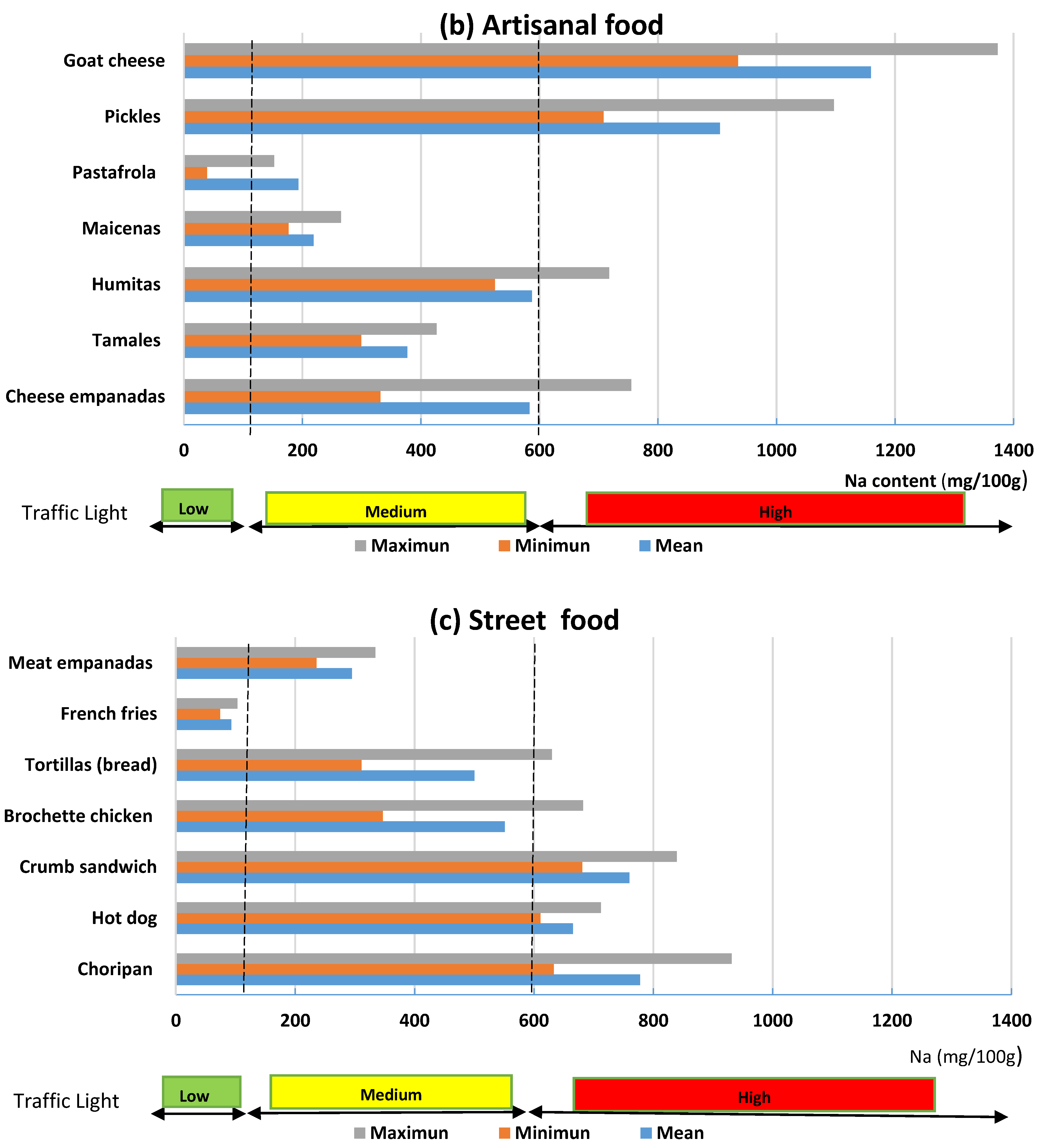Sodium Content in Commonly Consumed Foods and Its Contribution to the Daily Intake
Abstract
1. Introduction
2. Materials and Methods
2.1. Methodological Design
- n0: theoretical sample size;
- n′: final sample size;
- z2: zeta score is 1.96 for a 95% confidence level;
- p: maximum variability of the population at 50%. i.e., (0.5);
- q: 1−p = 0.5;
- e2: sampling error (0.05);
- 1−α: 95% confidence level;
- N: population size (3,800,000), which covers three provinces of Northwestern Argentina.
- The resulting (n′) was 384 people.
2.2. Food Categories
2.3. Survey
2.4. Food Sampling Plan
- 7 food items from each category were selected and 9 samples from each were analyzed.
- 7 foods × 3 categories = 21 foods to sample
- 21 foods × 9 samples/food = 189 samples to collect (total)
2.5. Sample Preparation
2.6. Chemical Analysis
2.7. Statistical Analysis
3. Results
4. Discussion
5. Conclusions
Author Contributions
Funding
Acknowledgments
Conflicts of Interest
Appendix A
| QUESTIONNAIRE. | |
| Province: | Date: |
| Age: | Sex: |
| 4 to 6 times per week | |
| twice daily | |
| once a day | |
| 2 to 3 times/week | |
| once a week | |
| monthly | |
| each 15 days | |
| every two months |
| Yes | No | I do not know | Unanswered |
| Yes | No | I do not know | Unanswered |
| Yes | No | I do not know | Unanswered |
| Always | Sometimes | Rarely | Never |
| Too much | Few | I do not know | No answer |
| Yes | No | I do not know |
| Yes | No | I do not know | Unanswered |
References
- World Health Organization. “Best Buys” and Other Recommended Interventions for the Prevention and Control of Noncommunicable Diseases. Available online: https://apps.who.int/iris/bitstream/handle/10665/259232/WHO-NMH-NVI-17.9-eng.pdf (accessed on 1 August 2019).
- Goncalves, C.; Abreu, S.; Padrao, P.; Pinho, O.; Graca, P.; Breda, J.; Santos, R.; Moreira, P. Sodium and potassium urinary excretion and dietary intake: A cross-sectional analysis in adolescents. Food Nutr. Res. 2016, 60, 29442. [Google Scholar] [CrossRef] [PubMed]
- Batuman, V. Salt and hypertension: Why is there still a debate? Kidney Int. Suppl. 2013, 3, 316–320. [Google Scholar] [CrossRef] [PubMed]
- Aburto, N.; Ziolkovska, A.; Hooper, L.; Elliott, P.; Cappuccio, F.; Meerpohl, J. Effect of lower sodium intake on health: Systematic review and meta-analyses. BMJ 2013, 346, f1326. [Google Scholar] [CrossRef] [PubMed]
- Sacks, F.; Svetkey, L.; Vollmer, W.; Appel, L.; Bray, G.; Harsha, D.; Obarzanek, E.; Conlin, P.; Miller, E.; Simons-Morton, D.; et al. Effects on blood pressure of reduced dietary sodium and the Dietary Approaches to Stop Hypertension (DASH) diet. DASH-Sodium Collaborative Research Group. N. Engl. J. Med. 2001, 344, 3–10. [Google Scholar] [CrossRef] [PubMed]
- He, F.; Macgregor, G. Effect of longer term modest salt reduction on blood pressure: Cochrane systematic review and meta-analysis of randomised trials. BMJ 2013, 346, f1325. [Google Scholar] [CrossRef] [PubMed]
- Cappuccio, F.; Beer, M.; Strazzullo, P. Population dietary salt reduction and the risk of cardiovascular disease. A scientific statement from the European Salt Action Network. Nutr. Metab. Cardiovasc. Dis. 2019, 29, 107–114. [Google Scholar] [CrossRef] [PubMed]
- Cappuccio, F. Cardiovascular and other effects of salt consumption. Kidney Int. Suppl. 2013, 3, 312–315. [Google Scholar] [CrossRef] [PubMed]
- Cappuccio, F.; Capewell, S.; Lincoln, P.; McPherson, K. Policy options to reduce population salt intake. BMJ 2011, 343, d4995. [Google Scholar] [CrossRef] [PubMed]
- Pan American Health Organization–World Health Organization. Cardiovascular Disease Prevention through Dietary Salt Reduction; Pan American Health Organization: Washington, DC, USA, 2011; Available online: http://new.paho.org/hq/index.php?option=com_content&view=article&id=2015&Itemid=1757&lang=es (accessed on 18 July 2019).
- World Health Organization. Informe Sobre la Salud en el Mundo 2002: Reducir Los Riesgos y Promover una Vida Sana; OMS: Ginebra, Switzerland, 2002; Available online: http://www.who.int/whr/2002/es/ (accessed on 14 June 2019).
- Ministerio de Salud de la Nación. Tercera Encuesta Nacional de Factores de Riesgo Para Enfermedades no Transmisibles (ENFR) 2013. Available online: http://www.msal.gov.ar/images/stories/bes/graficos/0000000544cnt-2014-09_3er-encuesta-nacional-factores-riesgo.pdf (accessed on 10 May 2019).
- Jereb, S. Consumo de sodio en la dieta de un argentino promedio y su relación con la Hipertensión Arterial. Incidencia de los alimentos, aguas y bebidas. Diaeta 2016, 34, 29–31. [Google Scholar]
- Kloss, L.; Dawn Meyer, J.; Graeve, L.; Vetter, W. Sodium intake and its reduction by food reformulation in the European Union—A review. NFS J. 2015, 1, 9–19. [Google Scholar] [CrossRef]
- He, F.; Mac Gregor, G. Salt and sugar: Their effects on blood pressure. Pflug. Arch. Eur. J. Physiol. 2015, 467, 577–586. [Google Scholar] [CrossRef] [PubMed]
- LEY 26.905. Promoción de la reducción del consumo de sodio en la población, Buenos Aires. 2013. Available online: http://test.e-legis-ar.msal.gov.ar/leisref/public/showAct.php?id=22097 (accessed on 12 July 2019).
- Ferrante, D.; Apro, N.; Ferreira, V.; Virgolini, M.; Aguilar, V.; Sosa, M.; Perel, P.; Casas, J. Feasibility of salt reduction in processed foods in Argentina. Rev. Panam. Salud Publica 2011, 29, 69–75. [Google Scholar] [CrossRef] [PubMed]
- Calliope, S.; Samman, N. Sodium content in foods consumed by Argentines: Monitoring compliance with agreements, in labels and samples. J. Food Compos. Anal. 2019, 83, 103289. [Google Scholar] [CrossRef]
- Vázquez, S.; Lema, R.; Silvia, N.; Contarini, C.; Kenten, C. Sal y salud, el punto de vista del consumidor argentino obtenido por la técnica de grupos focales. Rev. Chil. Nutr. 2012, 39, 182–190. [Google Scholar] [CrossRef]
- Cochran, W.G. Sampling Techniques, 3rd ed.; John Wiley & Sons: Hoboken, NJ, USA, 2007; pp. 363–365. [Google Scholar]
- Association of Official Analytical Chemists (AOAC). Official Methods of Analysis of AOAC, 20th ed.; AOAC: Washington, DC, USA, 2016; Available online: https://www.aoac.org/AOAC_Prod_Imis/AOAC_Member/Default.aspx?WebsiteKey=2e25ab5a-1f6d-4d78-a498-19b9763d11b4&hkey=8fc2171a-6051-4e64-a928-5c47dfa25797 (accessed on 12 August 2019).
- Resolución Conjunta 12/2019. Secretaría de Regulación y Gestión Sanitaria y Secretaría de Alimentos y Bioeconomía. Available online: https://www.boletinoficial.gob.ar/detalleAviso/primera/206649/20190430 (accessed on 23 October 2019).






| Variable | Category | Frequency (%) |
| Age | up to 20 years | 15.00 |
| up to 30 years | 70.00 | |
| up to 40 years | 8.33 | |
| up to 50 years | 6.67 | |
| Sex | Female | 73.00 |
| Male | 27.00 | |
| Survey Questions | Answers | Frequency (%) |
| Do you try to eat healthy diet? | Yes | 76.79 |
| No | 7.14 | |
| I donot know | 3.57 | |
| Unanswered | 12.50 | |
| Do you try to minimize salt intake? | Yes | 73.21 |
| No | 8.93 | |
| I donot know | 8.93 | |
| Unanswered | 8.93 | |
| Do you know which foods contain much salt? | Yes | 66.07 |
| No | 21.43 | |
| I donot know | 5.36 | |
| Unanswered | 7.14 | |
| How many times do you add salt on your meals? | Always | 3.57 |
| Sometimes | 41.07 | |
| Rarely | 33.93 | |
| Never | 21.43 | |
| How much salt do you think consume? | Too much | 26.79 |
| Few | 67.86 | |
| I donot know | 3.57 | |
| No answer | 1.79 | |
| Have you had hypertension problems? | No | 87.50 |
| yes | 12.50 | |
| Do you know if there is a recommended amount of salt intake? | Yes | 17.86 |
| No | 76.79 | |
| I donot know | 5.36 | |
| Do you know the difference between salt and sodium? | Yes | 67.86 |
| No | 17.86 | |
| Unanswered | 5.36 | |
| I donot know | 8.93 |
| Category | Subcategories | Ingredients/UW-MSS * | Photo |
|---|---|---|---|
| Artisanal food | Cheese empanada | Dough, cheese, onion, pea, egg, potato UW: 56 g MSS: 168 g (3 units) |  |
| Goat cheese | Goat milk, rennet, salt. UW: 366 g MSS: 60g |  | |
| Tamales | Cornmeal, meat, potatoes, condiments UW: 142 g MSS: 284 g (2 units) |  | |
| Humitas | Ground fresh cornpaste, semi-hard cheese, pumpkin, seasonings UW: 231 g MSS:463 g (2 units) |  | |
| Pickles | Chili pepper, carrot, onion, broccoli, cauliflower, vinegar, salt UW: 562 g MSS: 50 g (2 table spoon) |  | |
| Pastafrola | Wheat-flour, butter, eggs, quince jam, sugar UW: 405 g MSS: 102 g |  | |
| Maicenas | Wheat flour, corn starch, eggs, butter, sugar, caramel, grated coconut UW: 53 g MSS: 159 g (3 units) |  | |
| Fast food | Pizzas | Base dough: Wheat flour, oil, salt, yeast; toppings: Cheese, tomato sauce, olives, chili pepper UW: 513 g (1 medium pizza) MSS: 193 g (3/8 portions) |  |
| Napolitan milanese | Breaded beef-steak (covered with egg and breadcrumbs); toppings: tomato sauce, cheese, cooked ham, olives; accompanied by fried egg and Frenchfries UW: 608 g (1 plate) MSS: 304 g (1/2 plate) |  | |
| Simple Hamburger | Bread, beef burger, egg, tomato, lettuce, ham, cheese, mayonnaise, ketchup UW: 217 g MSS: 217 g |  | |
| Loin sandwich | Bread, beef-steak, fried egg, tomato, lettuce, mayonnaise UW: 364 g (1 sandwich): MSS: 364 g |  | |
| Milanese sandwich | Bread, milanese, fried egg, ham, cheese, tomato, lettuce, mayonnaise UW: 394 g (1 sandwich) MSS: 394 g |  | |
| Chicken with salad | Chicken leg and lettuce and tomato salad UW: 422 g (1 plate) MSS: 422 g |  | |
| Chard cake | Wheat-flour dough, chard, beaten egg, onion, grated cheese, condiments UW: 383 g MSS: 192 g (Half unit) |  | |
| Street food | French fries | French fries, mayonnaise, salt UW: 81 g MSS: 81 g |  |
| Hot dog | Vienna bread, sausage, mustard, mayonnaise, ketchup UW: 77 g MSS: 154 g (2 units) |  | |
| Crumb sandwich | Crumb bread, ham, cheese, mayonnaise UW: 65 g MSS: 195 g (3 units) |  | |
| Chicken brochette | Spiced chicken, sliced onion, pepper or roasted tomato. UW: 183 g MSS: 386 g (2 units) |  | |
| Tortillas (bread) | Wheat flour dough, fat, water UW: 426 g MSS: 213 g (Half unit) |  | |
| Choripan | French-type bread and pork sausage, mayonnaise. UW: 179 g MSS: 179 g |  | |
| Meat empanadas | Wheat flour dough, ground meat, onion, pea, potato, hardboiled egg UW: 59 g MSS: 177 g (3 units) |  |
© 2019 by the authors. Licensee MDPI, Basel, Switzerland. This article is an open access article distributed under the terms and conditions of the Creative Commons Attribution (CC BY) license (http://creativecommons.org/licenses/by/4.0/).
Share and Cite
Calliope, S.R.; Samman, N.C. Sodium Content in Commonly Consumed Foods and Its Contribution to the Daily Intake. Nutrients 2020, 12, 34. https://doi.org/10.3390/nu12010034
Calliope SR, Samman NC. Sodium Content in Commonly Consumed Foods and Its Contribution to the Daily Intake. Nutrients. 2020; 12(1):34. https://doi.org/10.3390/nu12010034
Chicago/Turabian StyleCalliope, Sonia Rosario, and Norma Cristina Samman. 2020. "Sodium Content in Commonly Consumed Foods and Its Contribution to the Daily Intake" Nutrients 12, no. 1: 34. https://doi.org/10.3390/nu12010034
APA StyleCalliope, S. R., & Samman, N. C. (2020). Sodium Content in Commonly Consumed Foods and Its Contribution to the Daily Intake. Nutrients, 12(1), 34. https://doi.org/10.3390/nu12010034






